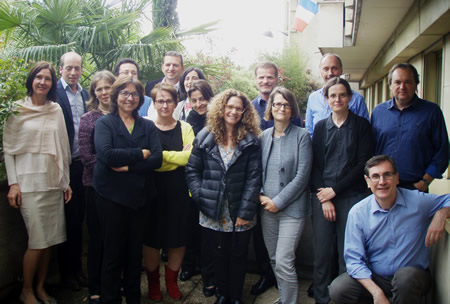
53rd meeting of the Panel on Phytosanitary Measures
Paris, 2016-05-18/20
The Panel met in Paris in the EPPO headquarters on 2016-05-18/20. The main task of this Panel is to evaluate risks presented by specific pests and design phytosanitary measures to avoid their introduction and spread.

Participants
EPPO lists of pests recommended for regulation
The Panel reviewed in detail one PRA prepared by an Expert Working Group for PRA on Lycorma delicatula and PRA reports prepared on the basis of the EFSA opinion Scientific Opinion on the assessment of the risk of solanaceous pospiviroids for the EU territory and the identification and evaluation of risk management options. A PRA prepared by Spain on the polyphagous shot hole borer (Euwallacea sp.) and Fusarium euwallaceae was also reviewed.
The Panel recommended to the Working Party the addition of the following pests to the EPPO Lists:
- A1 List: Lycorma delicatula, Pepper chat fruit viroid and Tomato planta macho viroid
- A2 List: polyphagous shot hole borer (Euwallacea sp.) and Fusarium euwallaceae, Citrus exocortis viroid, Columnea latent viroid, Tomato apical stunt viroid, Tomato chlorotic dwarf viroid
Following recent progress in taxonomy, the Panel recommended that Xanthomonas fuscans subsp. aurantifolii should be added to A1 list and Epitrix papa should replace E. similaris on the A2 List.
The Panel reviewed the present situation of A1 pests and considered that no pest should be transferred from the A1 to the A2 List. The situation of Anthonomus eugenii, Chrysanthemum stem necrosis virus and Xylella fastidiosa should be reviewed next year.
Alert List
The Panel reviewed the EPPO Alert List (the purpose of this List is to alert countries about possible new risks, and in certain cases to propose candidates for PRA). Considering that the alert had been given, the Panel decided to propose the deletion from the List of Ophiomyia kwansonis, Maize redness (Stolbur phytoplasma), and Syndrome des basses richesses. The Panel suggested a number of emerging pests that could be added to the Alert List (e.g. Aonidiella orientalis, Brevipalpus chilensis, Frankliniella cestrum, Zaprionus indianus and Z. tuberculatus).
Standards under development
The Panel finalized the Standard Guidelines on the phytosanitary measure ‘plants grown under complete physical isolation’ after country consultation. It will be presented to the Working Party on Phytosanitary Regulations for approval. The Panel reviewed a revised version of draft Guidelines to establish pest lists in commodity PRAs, and started discussing how to provide general guidelines on the establishment of buffer zones. These topics will be discussed further at the next meeting.
Pest Risk Analysis
The Panel reviewed the outcomes of the survey on circumstances for use of PRA schemes in the EPPO region. It recommended that EPPO should explore a way to easily share national PRAs or information on PRAs being conducted at national level.
The Panel was presented the new methodology under development by the EFSA Plant Health Panel for pest risk assessment.
The Panel discussed the new process under which short PRAs were produced for pests identified during the EPPO Study on pest risks associated with the import of tomato fruit. Lessons learned from this experience will be useful if EPPO perform commodity PRAs in the future. The PRAs on Ceratothripoides brunneus, Bactrocera latifrons, Aleurotrachelus trachoides and Prodiplosis longifila will be reviewed at the next meeting.
The Panel considered the conclusions of the EWG on possible management measures for soil and growing media attached to plants to sustain their vitality and made further recommendations to the Working Party.
In addition to the review of PRAs (see above) the Panel established the priorities for the organization of EWGs for PRA. The selection was made taking into account the following elements: geographical distribution, importance of the crop(s) concerned, risk of natural spread into the region or for further spread within the region, potential pathways, economic impact, environmental impact, possibilities of control, similarities to other known cases, availability and validity of data. The Panel agreed that 'Candidatus Phytoplasma phoenicium' had a high priority, Massicus raddei and Grapevine red blotch-associated virus a moderate priority and Tekopsora minima a lower priority for PRA. This will be further discussed by the Working Party. The Panel will also review a number of national PRAs or EFSA opinions (e.g. Strauzia longipennis, Platynota stultana, Citrus bark cracking viroid, Pomacea maculata and P. canaliculata) to consider if these should be recommended for regulation.
Regulated Non-Quarantine Pests
The Panel was presented with the 2-year project contracted with the EU Commission (EU Quality Pest Project), which started in April 2016. Progress on this project will be presented to the Panel in the future.
Contingency plan
The Panel reviewed the National Regulatory Control System developed by an EWG for Popillia japonica and agreed that it could be sent for country consultation.
Update on DROPSA
An update on the progress made on the EU FP7 project DROPSA was presented It is expected that the final Alert lists of pests likely to be transported with fruit of apple, vaccinium, citrus, and grapevine are presented to the Panel at its next meeting.
The next Panel meeting is planned 2016-11-08/10 in Israel (IT).
